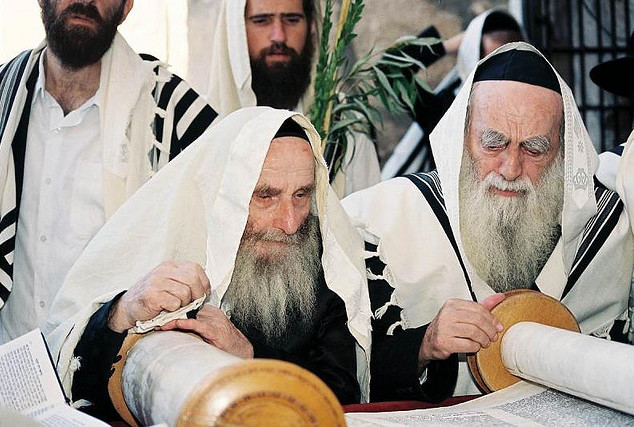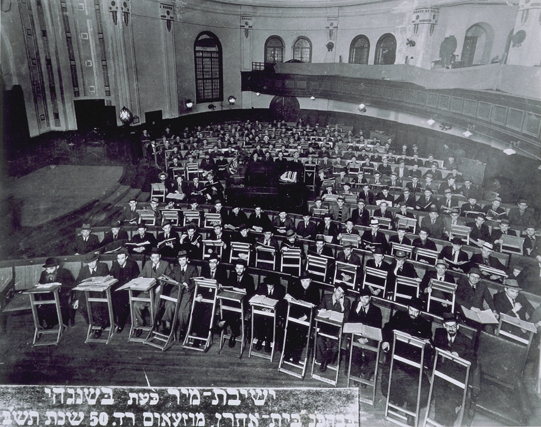|
Eliezer Yehuda Finkel (b. 1965)
Rav Eliezer Yehuda Finkel (also called Leizer Yudel Finkel) is a Haredi Jewish rosh yeshiva (dean) of the Mir Yeshiva in Jerusalem, which is considered to be the largest yeshiva in Israel with a student body of 6,000 students. He acceded to the position of rosh yeshiva after his father, Rabbi Nosson Tzvi Finkel, died suddenly on 8 November 2011. Biography Rav Finkel was named after his maternal great-grandfather, Rabbi Eliezer Yehuda Finkel, known as "Reb Leizer Yudel", who became rosh yeshiva of the Mir yeshiva in Poland in 1917 and re-established the yeshiva in Jerusalem during World War II whilst the main body of the Yeshiva was in exile in the Far East. His great-great-grandfather was the celebrated Mussar leader, the Alter of Slabodka Nosson Tzvi Finkel ( he, נתן צבי פינקל, Sephardic/Israeli: ''Natan Tzvi''; yi, נָטע הערש, Nota Hirsch; 1849–1927) was an influential Lithuanian Jewish leader of Orthodox Judaism in Eastern Europe and founder of ... [...More Info...] [...Related Items...] OR: [Wikipedia] [Google] [Baidu] |
Mir Yeshiva (Jerusalem)
The Mir Yeshiva ( he, ישיבת מיר, ''Yeshivas Mir''), known also as The Mir, is an Orthodox Jewish ''yeshiva'' in Beit Yisrael, Jerusalem. With over 9,000 single and married students, it is the largest yeshiva in the world.Krausz, Yossi. "Our Boys in Israel". ''Ami'', October 23, 2013, pp. 44-53. Most students are from the United States, United Kingdom and Israel, with many from other parts of the world such as Belgium, France, Mexico, Switzerland, Argentina, Australia, Russia, Canada and Panama. History The yeshiva was founded in the small town of Mir (now in Belarus) in 1814, 1815 or 1817 by Rabbi Shmuel Tiktinsky. After his death, his oldest son Rabbi Avraham Tiktinsky was appointed Rosh Yeshiva. After a number of years, Rabbi Avraham died and his younger brother Rabbi Chaim Leib Tiktinsky succeeded him. Rabbi Chaim Leib would remain as Rosh Yeshiva for many decades. He was succeeded by his son, Rabbi Avrohom Tiktinsky, who brought Rabbi Eliyahu Boruch Kamai into the ... [...More Info...] [...Related Items...] OR: [Wikipedia] [Google] [Baidu] |
Eliezer Yehuda Finkel (b
Eliezer Yehuda Finkel may refer to one of the two rosh yeshivas of the Mir yeshivas: * Eliezer Yehuda Finkel (born 1879) (1879–1965), also known as Reb Leizer Yudel, rosh yeshiva of the Mir yeshiva in Poland and Jerusalem * Eliezer Yehuda Finkel (born 1965), current rosh yeshiva of the Mir Yeshiva in Jerusalem {{hndis, Finkel, Eliezer Yehuda ... [...More Info...] [...Related Items...] OR: [Wikipedia] [Google] [Baidu] |
Living People
Related categories * :Year of birth missing (living people) / :Year of birth unknown * :Date of birth missing (living people) / :Date of birth unknown * :Place of birth missing (living people) / :Place of birth unknown * :Year of death missing / :Year of death unknown * :Date of death missing / :Date of death unknown * :Place of death missing / :Place of death unknown * :Missing middle or first names See also * :Dead people * :Template:L, which generates this category or death years, and birth year and sort keys. : {{DEFAULTSORT:Living people 21st-century people People by status ... [...More Info...] [...Related Items...] OR: [Wikipedia] [Google] [Baidu] |
21st-century Rabbis In Jerusalem
The 1st century was the century spanning AD 1 ( I) through AD 100 ( C) according to the Julian calendar. It is often written as the or to distinguish it from the 1st century BC (or BCE) which preceded it. The 1st century is considered part of the Classical era, epoch, or historical period. The 1st century also saw the appearance of Christianity. During this period, Europe, North Africa and the Near East fell under increasing domination by the Roman Empire, which continued expanding, most notably conquering Britain under the emperor Claudius (AD 43). The reforms introduced by Augustus during his long reign stabilized the empire after the turmoil of the previous century's civil wars. Later in the century the Julio-Claudian dynasty, which had been founded by Augustus, came to an end with the suicide of Nero in AD 68. There followed the famous Year of Four Emperors, a brief period of civil war and instability, which was finally brought to an end by Vespasian, ninth Roman emperor, ... [...More Info...] [...Related Items...] OR: [Wikipedia] [Google] [Baidu] |
Haredi Rabbis In Israel
Haredi Judaism ( he, ', ; also spelled ''Charedi'' in English; plural ''Haredim'' or ''Charedim'') consists of groups within Orthodox Judaism that are characterized by their strict adherence to ''halakha'' (Jewish law) and traditions, in opposition to modern values and practices. Its members are usually referred to as ultra-Orthodox in English; however, the term "ultra-Orthodox" is considered pejorative by many of its adherents, who prefer terms like strictly Orthodox or Haredi. Haredi Jews regard themselves as the most religiously authentic group of Jews, although other Jewish religious movements, movements of Judaism disagree. Some scholars have suggested that Haredi Judaism is a reaction to societal changes, including Jewish emancipation, political emancipation, the ''Haskalah'' movement derived from the Age of Enlightenment, Enlightenment, Jewish assimilation, acculturation, Jewish secularism, secularization, religious reform in all its forms from mild to extreme, the rise ... [...More Info...] [...Related Items...] OR: [Wikipedia] [Google] [Baidu] |
Rosh Yeshivas
Rosh yeshiva ( he, ראש ישיבה, pl. he, ראשי ישיבה, '; Anglicized pl. ''rosh yeshivas'') is the title given to the dean of a yeshiva, a Jewish educational institution that focuses on the study of traditional religious texts, primarily the Talmud and the Torah, and ''halakha'' (Jewish law). The general role of the rosh yeshiva is to oversee the Talmudic studies and practical matters. The rosh yeshiva will often give the highest ''shiur'' (class) and is also the one to decide whether to grant permission for students to undertake classes for rabbinical ordination, known as ''semicha''. The term is a compound of the Hebrew words ''rosh'' ("head") and ''yeshiva'' (a school of religious Jewish education). The rosh yeshiva is required to have a comprehensive knowledge of the Talmud and the ability to analyse and present new perspectives, called ''chidushim'' (novellae) verbally and often in print. In some institutions, such as YU's Rabbi Isaac Elchanan Theological Semin ... [...More Info...] [...Related Items...] OR: [Wikipedia] [Google] [Baidu] |
Nosson Tzvi Finkel (Slabodka)
Nosson Tzvi Finkel ( he, נתן צבי פינקל, Sephardic/Israeli: ''Natan Tzvi''; yi, נָטע הערש, Nota Hirsch; 1849–1927) was an influential Lithuanian Jewish leader of Orthodox Judaism in Eastern Europe and founder of the Slabodka yeshiva, in the town of Sloboda Vilyampolskaya (now Vilijampolė, a suburb of Kaunas). He is also known by the Yiddish appellation ''der Alter'' ("the Elder") and as the Alter of Slabodka. Many of his pupils were to become major leaders of Orthodox Judaism in the USA and Israel. Early years Rabbi Finkel was born in 1849 to Reb Moshe Finkel and was orphaned at an early age, not much is known about his formative years. At a young age, he went to study at the Kelm Talmud Torah under Rabbi Simcha Zissel Ziv, "the Alter of Kelm." Philosophical approach Despite his influence, he was an intensely private person. Yet, he personally oversaw the complete student body of the yeshiva. His motto was summed up in the words ''Gadlus HaAdam'' ("Greatn ... [...More Info...] [...Related Items...] OR: [Wikipedia] [Google] [Baidu] |
Mussar Movement
The Musar movement (also Mussar movement) is a Jewish ethical, educational and cultural movement that developed in 19th century Lithuania, particularly among Orthodox Lithuanian Jews. The Hebrew term (), is adopted from the Book of Proverbs (1:2) describing moral conduct, instruction or discipline, educating oneself on how one should act in an appropriate manner. The term was used by the Musar movement to convey the teachings regarding ethical and spiritual paths. The Musar movement made significant contributions to Musar literature and Jewish ethics. The movement has been revived in the 21st century amongst Jews of all denominations, particularly in the United States. Origin The Musar movement arose among non-Hasidic Orthodox Lithuanian Jews as a response to the social changes brought about by the Enlightenment, and the corresponding Haskalah movement among many European Jews. In this period of history anti-Semitism, the assimilation of many Jews into Christianity, and the i ... [...More Info...] [...Related Items...] OR: [Wikipedia] [Google] [Baidu] |
Mir Yeshiva (Belarus)
The Mir Yeshiva ( he, ישיבת מיר, ''Yeshivas Mir''), commonly known as the Mirrer Yeshiva ( yi, מירער ישיבה) or The Mir, was a Lithuanian yeshiva located in the town of Mir, Russian Empire (now Belarus). After relocating a number of times during World War II, it has evolved into three yeshivas, one in Jerusalem, with a subsidiary campus in Brachfeld, Modi'in Illit, and the other two in Brooklyn, New York: the Mir Yeshiva, and Bais Hatalmud. Origins The Mirrer Yeshiva was founded in 1815, 12 years after the founding of the Volozhin Yeshiva, by one of the prominent residents of a small town called Mir (then in Grodno Governorate, Russian Empire), Rabbi Shmuel Tiktinsky. After Rav Shmuel's death, his youngest son, Rabbi Chaim Leib Tiktinsky, was appointed rosh yeshiva. He was succeeded by his son, Rav Avrohom, who brought Rabbi Eliyahu Boruch Kamai into the yeshiva. During Rabbi Kamai's tenure the direction of the yeshiva wavered between those who wished to in ... [...More Info...] [...Related Items...] OR: [Wikipedia] [Google] [Baidu] |
Mir Yeshiva (Belarus)
The Mir Yeshiva ( he, ישיבת מיר, ''Yeshivas Mir''), commonly known as the Mirrer Yeshiva ( yi, מירער ישיבה) or The Mir, was a Lithuanian yeshiva located in the town of Mir, Russian Empire (now Belarus). After relocating a number of times during World War II, it has evolved into three yeshivas, one in Jerusalem, with a subsidiary campus in Brachfeld, Modi'in Illit, and the other two in Brooklyn, New York: the Mir Yeshiva, and Bais Hatalmud. Origins The Mirrer Yeshiva was founded in 1815, 12 years after the founding of the Volozhin Yeshiva, by one of the prominent residents of a small town called Mir (then in Grodno Governorate, Russian Empire), Rabbi Shmuel Tiktinsky. After Rav Shmuel's death, his youngest son, Rabbi Chaim Leib Tiktinsky, was appointed rosh yeshiva. He was succeeded by his son, Rav Avrohom, who brought Rabbi Eliyahu Boruch Kamai into the yeshiva. During Rabbi Kamai's tenure the direction of the yeshiva wavered between those who wished to in ... [...More Info...] [...Related Items...] OR: [Wikipedia] [Google] [Baidu] |

.jpg)



